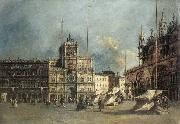La Peinture à l'huile en gros de Chine & Encadre |
|||||||||||

|
|||||||||||
|
|
|
||||||||||||||
|
GUARDI, Francesco
Italian Rococo Era Painter, 1712-ca.1793 |
||||||||||||||
|
|
||||||||||||||
|
||||||||||||||
|
|
||||||||||||||
| GUARDI, Francesco
Italian Rococo Era Painter, 1712-ca.1793 The_Torre_del'Orologio 1765-70 Oil on canvas, 62,5 x 89,4 cm Akademie der bildenden K?nste, Vienna Ever since the early sixteenth century the view of Piazza San Marco has been partly determined by the Torre dell'Orologio, the construction of which was largely completed in 1506. Francesco Guardi represented the building here with the two storeys added to the wings in 1755. To the left of this is part of the Procuratie Vecchie, which at that time accommodated the procurators of San Marco, the most important representative magistracy after the Doge; on the right is the Basilica itself. It is striking that the square does not display the geometrical patterns of the paving which was laid in about 1723. Guardi recorded the view from a vantage point beyond the Campanile, though he adapted the result of his observations somewhat for the sake of the composition. By placing the walls of the Procuratie and the Torre parallel to the picture plane, the angle between these structures and the fa?ade of San Marco appear greater than in reality. This also has the effect of making the square much more spacious. There are also several details which do not entirely correspond with the actual situation, such as the three flagstaffs, which have been depicted lower and thinner than in actuality. A drawing by Guardi has been preserved that is virtually identical in terms of detail to the painting. Despite the prominent place of the Torre dell'Orologio it was seldom chosen as an independent motif by the Venetian vedutisti. Carlevaris and Canaletto did include it in paintings, but only as an incidental feature, and furthermore from a different angle. Francesco Guardi painted this theme at least eight times, always from virtually the same vantage point. Each time he gave a slightly different impression of the space by varying the relationships, the light and the positioning of the figures. In this painting the foreground is almost empty and the depth is only accentuated by the strikingly foreshortened fa?ade of San Marco and the lines of the three flagstaffs running parallel to it, and by the tents fluttering fitfully in the wind. In this simple composition Guardi emphasized the play of light and colour on the walls and the pavement. Artist: GUARDI, Francesco Painting Title: The Torre del'Orologio , 1751-1800 Painting Style: Italian , , landscape 1765-70 Oil on canvas, 62,5 x 89,4 cm Akademie der bildenden K?nste, Vienna Ever since the early sixteenth century the view of Piazza San Marco has been partly determined by the Torre dell'Orologio, the construction of which was largely completed in 1506. Francesco Guardi represented the building here with the two storeys added to the wings in 1755. To the left of this is part of the Procuratie Vecchie, which at that time accommodated the procurators of San Marco, the most important representative magistracy after the Doge; on the right is the Basilica itself. It is striking that the square does not display the geometrical patterns of the paving which was laid in about 1723. Guardi recorded the view from a vantage point beyond the Campanile, though he adapted the result of his observations somewhat for the sake of the composition. By placing the walls of the Procuratie and the Torre parallel to the picture plane, the angle between these structures and the fa?ade of San Marco appear greater than in reality. This also has the effect of making the square much more spacious. There are also several details which do not entirely correspond with the actual situation, such as the three flagstaffs, which have been depicted lower and thinner than in actuality. A drawing by Guardi has been preserved that is virtually identical in terms of detail to the painting. Despite the prominent place of the Torre dell'Orologio it was seldom chosen as an independent motif by the Venetian vedutisti. Carlevaris and Canaletto did include it in paintings, but only as an incidental feature, and furthermore from a different angle. Francesco Guardi painted this theme at least eight times, always from virtually the same vantage point. Each time he gave a slightly different impression of the space by varying the relationships, the light and the positioning of the figures. In this painting the foreground is almost empty and the depth is only accentuated by the strikingly foreshortened fa?ade of San Marco and the lines of the three flagstaffs running parallel to it, and by the tents fluttering fitfully in the wind. In this simple composition Guardi emphasized the play of light and colour on the walls and the pavement. Artist: GUARDI, Francesco Painting Title: The Torre del'Orologio , 1751-1800 Painting Style: Italian , , landscape |
||||||||||||||
|
Related Paintings to GUARDI, Francesco :. |
||||||||||||||
|
|
||||||||||||||
|
|
||||||||||||||
|
CONTACTER DES Etats-Unis |







